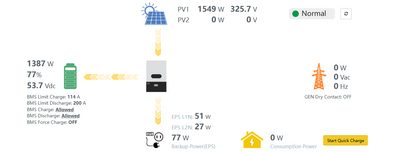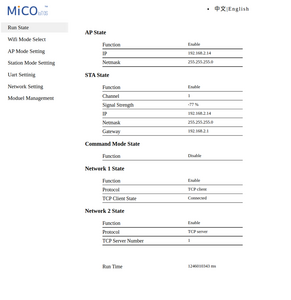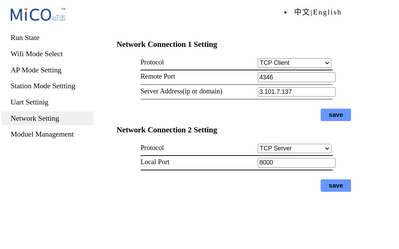system display pannel
Wondering if EG4 eco system has a way to display the whole think on a touch screen or tablet, something that might look a bit like the Victron GX touch 50 / cerbo system.
If a station is created and connected to the monitoring website, you can access it from any device using the EG4 Monitor app or through the website. If the inverter is not connected to the server, you can still connect locally via the app to view inverter data and adjust settings. The app is available for both iOS and Android devices.
I don't know if it is what you mean but you can use a tablet and either connect to the web monitor or use the app and connect to the local connect if you don't have internet service.
JB
Sometimes the easiest solution is the best solution.
Sometimes not.
"Local Connect" on the EG4 Android app is good news.
I did not know that this was an option.
The method of connecting to my EG418kpv through the "web tunnel" has not been reliable. Maybe about 80% timeout errors. So changing a setting is time consuming.
timeouts tend to occur in clusters (as to successes) so the time required to make a change can be hours.
On the other hand, solarassistant (which uses direct WiFi connection to the EG4 18kPV) is reliable, I have not noticed any communication failures with solarassistant.
I assume the EG4 monitor web cloud system uses a "reverse SSH tunnel" from the WiFi dongle to the Amazon services cloud, then the code in the cloud uses TCP modbus down the tunnel to get/set data from the EG4 18Kpv.
This sometimes works.
My internet connection to the EG418kPV is starlink, it uses CGNAT, maybe that is the problem.
Or maybe running solarassistant, which also uses the dongles WiFi to get data is the problem (multiple WiFi connections to the EG418kpvs dongle).
This is good stuff, how to get it to work?
When trying to connect via the EG4 Android app (via the login page, LOCAL CONNECT, I get "Message: Connect dongle of device failed". I know that the dongle is connected to my WiFi AP since solarassistant and the web monitor always at least pretends to be connected and sometimes lets me change a setting.
It's not uncommon that I miss something that's obvious to everyone else.
I hope this is another time.
George
Replying to myself:
I noticed this https://monitormy.solar/detail/13
This is a replacement for the EG4 WiFi dongle.
It's not clear what it does that the EG4 dongle does not other than it can export data to a different cloud service and may have documentation.
It seems to explicitly allow local access to these parameters: https://docs.google.com/spreadsheets/u/0/d/e/2PACX-1vR4tZ2UopYAXOcbB-V2PBKrQcNggaNLVUVmEvsgTGT4QR2sZgZDx9IUCbyvXlMDCiloVYx5vaqqbb4f/pubhtml?ref=danielraffel.me&pli=1
and has a export to home-assistant mechanism described here: https://github.com/zakery292/monitormysolar
So far, I have found 1 instance of someone using this "new dongle" with an EG4 18Kpv : https://danielraffel.me/2024/10/28/how-i-built-a-real-time-solar-dashboard-for-my-eg4-18kpv-inverter-using-home-assistant/
This seems like a better monitoring method than the current EG4 solution.
Maybe EG4 is working on something similar.
Maybe a firmware update to the EG4 18Kpv will make this stop working ?
Has anyone had a reliable instance of the EG4 monitoring web app being a reliable system for monitoring and control of an EG4 18kpv?
If so, what conditions are required for reliable operation ?
George
@george-redinger When you want to use the "local connect" in the app, your device needs to be connected to the dongles network.
Posted by: @george-redingerMy internet connection to the EG418kPV is starlink, it uses CGNAT, maybe that is the problem.
I use Starlink as well and the greatest delay I have ever experienced is maybe a couple of seconds. And since you indicate that solar assistant is responsive, I almost wonder if there may be an issue with your dongle or your dongles connection to your local wi-fi.
I don't know if there are any diagnostics that can be run on the dongle itself but maybe @jared can offer some suggestion on that side.
Regarding the dongles wi-fi, would you happen to have a net-extender laying around you could set up in the vicinity of the 18K?
JB
Sometimes the easiest solution is the best solution.
Sometimes not.
While Solar Assistant is an excellent third-party option, using it alongside the Wi-Fi dongle connected to our servers may cause connectivity issues. This happens because both systems share the same connection to the dongle, which can interfere with the transmission and receiving of information to our server.
Yes, this appears to be the case (interference between EG4s cloud monitoring system and solarassistant).
Suspecting this (this morning) I disconnected solarassistant (clicking the Dissconnect button in solarassistant), then went to the EG4 cloud monitoring system.
With solarassistant disconnected, the EG4 cloud monitor site works well in "maintenance" mode changing settings was 100 % effective ( I tried 3 times all worked )
telling solarassistant to reconnect solarassistant would not reconnect. Removing the inverters configuration (EG4 18Kpv, Luxpower, dongle serial number and inverter serial number) and then adding it back in, solarassistant reconnects.
Then, back to the EG4 cloud monitoring, it sometimes works again.
This seems to be related to the length of the data transfer triggered from clicking the [Read] button in the [Maintenance > Remote Set] page in the EG4 cloud monitoring web app. I suspect that solarassistant often comes in when the Remote Set is not done with all the modbus register reads yet, so the cloud monitoring web app displays a timeout message.
Solarassistant and EG4 cloud monitoring are not coordinated, each assume they are the only thing.
Modbus reads and writes 16 bit registers, Reading all the EG4 18kpvs settings is a lot of registers.
My limited knowledge of modbus TCP is that there exists the concept of transaction locking in the protocol.
It seems likely that one, the other or both (solarassistant and EG4 cloud monitoring) use modbus TCP transaction locking.
For them both to operate simultaneously, they would both have to respect transaction locking.
(and read the modbus TCP docs to understand if they existing modbus TCP standard will allow for multi masters and transaction locking)
If I can get the android client to directly connect to my EG4 18Kpv I will not need cloud monitoring to changes settings.
Is there guidance on how to connect the android monitoring app achieve direct connection ?
George
I don't believe we have a guide currently made. However, the Android device must be within range of the signal emitted by the Wi-Fi dongle. By connecting to the local network created by the dongle, you can establish a connection via Wi-Fi or Bluetooth on Android devices. However, the range is limited to approximately 5 feet due to the dongle's low signal strength.
@jared Just out of curiosity, would an end user still experience connectivity issues with local connect when Solar Assistant is in use as well?
JB
Sometimes the easiest solution is the best solution.
Sometimes not.
@joel-brodeur I'm not entirely sure, as I do not have any testing data when using the local connection and Solar Assistant simultaneously.
More good info, what to connect to?
The default IP address for the EG4 18kpv WiFi dongle is 10.10.10.1.
after configuration, which allows the dongle to connect to cloud monitoring the IP address will be on my local networks subnet (the dongle must connect to my WiFi access point, which in turn has an internet connection.
The dongle has a local embeded webserver which serves a webpage with it's configuration information:
That's a screen shot of my EG4 18kpv's dongle page. As shown it's been configured to a static IP address on my local networks subnet.
Do I connect the android app to the dongles IP address as configured, to 10.10.10.1 or to something else.
I can connect to the dongle over several hundred feet distance since I have a wired network with several access points which all have access to my local subnet.
It seems that there is something fundamental about the EG4 android monitoring app that I do not understand. (The screenshot of the dongles http web page was retrieved from the dongle at a distance > 5 feet, what am I missing about the distance from dongle ?)
On a related question. I am looking at how to maintain my solarassistant (and possibly android direct connect monitor) by disabling the connection to the EG4 cloud monitoring, it appears to do so, I would remove the cloud servers IP address from this dongle page:
remove address 3.101.7.137 (saving it, to restore later, in case I cannot get the android app direct connect to work).
Hopefully this will not cause the dongle to go into a panic mode if it cannot connect.
Is this the "proper" way to disconnect from cloud monitoring?
George.
Replying to my self again,
I've seen some complaints that the cloud monitoring is hosted in Shanghai.
The IP address 3.101.7.137 , according to amazons EC2 ip ranges, this is in region "us-west-1" which according to Amazon's documentation , is near San Francisco.
Maybe near China Town?
The server location may vary depending on the geographic location where it is deployed. All EG4 monitoring servers may be at the same location, the internet goes everywhere, except to and from some places such as China, which has special constraints. The AWS server(s) in San Francisco may well send all the data to Shanghai.
But it's easier to be a spy in San Francisco than in Shanghai.
George
I went ahead and made a quick video guide on how to locally connect to the Wi-Fi dongle.
Thanks for the demo of local connect with the EG4 Android app.
From what I can tell from the demo video, this is using the EG4 18Kpv WiFi module in AP mode.
For context, WiFi "nodes" can operate in Station mode (STA) or Access Point Mode (AP).
It is possible to operate in both modes simultaneously (assuming the device allows it)
If in AP mode, the client device (Android device in this case) will have a direct radio connection to the EG4 WiFi dongle (cannot be connected through an IP network over arbitrary distances).
Solarassistant, makes a connection to the EG4 WiFi dongle in STA mode. Hence, other clients can also connect, (such as the connection to the internet to the cloud monitoring system.
The most desirable Android app would connect via STA mode to allow adjusting parameters while allowing cloud monitoring and local monitoring via solarassistant or any other local WiFi client I might find or create.
In logged in mode (of the Android app) the app connects to the internet which connects to a Amazon cloud service, which has an existing connection (created by the WiFi dongles software, which allows the cloud software to connect (through the tunnel created by the WiFi dongle) via STA mode to the dongle which can get and set parameters in the Inverter. Whew, a long path to avoid going out in the cold to use the touch screen.
How close to correct is my interpretation of how things work?
I noticed that the EG4 18kpv has 2 interesting RJ45 connectors:
Battery and RS485.
The Battery connector seems to be a CAN bus connector which the inverter uses to read battery state.
The RS485 is unclear (to me at least), is this another way to execute Modbus RS485 RTU protocol to the inverter and then get/set all the things that the WiFi based Android app and cloud monitoring do ?
If so, this seems to be another way to do local monitoring and control.
This would be a fun project to build a box that encodes and decodes (from a Modbus RS485 RTU wired connection) all the registers and presents them in what ever form over what ever transport medium desired.
I assume the HDMI shaped connector that the EG4 WiFi dongle plugs into is used for serial data to and from the WiFi dongle. If this where documented it would also be a way access Modbus RTU commands and create a wired monitoring and control system.
I was not able to get the Android app direct connect mode. Since it appears that I would need to disconnect the Android device from my local network, then connect to the EG4 WiFi dongle to use it, if I did get it to work I would only use it if my internet connection was down and setting provided by solarassistant where not sufficent.
All this is not a complaint. I too have created messes. Finding a simple way out of the mess is enjoyable.
George
- 35 Forums
- 900 Topics
- 4,872 Posts
- 3 Online
- 1,462 Members




